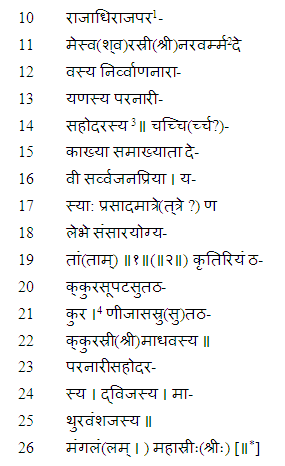|
The Indian Analyst
|
North Indian Inscriptions |
INSCRIPTIONS OF THE PARAMARAS OF MALWA
No. 37 ; PLATE XXXIX ...THE stone bearing this inscription was found about forty years ago in the ruins at Bhilsā (now known as Vidishā), the chief town of a District of the same name in Madhya Pradesh, and for some years was lying among the antiquities exhibited in the garden of the Dawk Bungalow, forming a sort of open-air Museum at that place. The inscription was very briefly and wrongly noticed in the Quinquennial Administrative Report of the Archaeological Department of the (former) Gwalior State, for the years 1942-46, page 25, where it is said that “it seems to have been a praśasti recording the merits of a distinguished personage, perhaps a king or a minister who is compared to the Sun but whom, very unlike the Sun, Rāhu could not hold in his grip. As the inscription is badly mutilated, its object cannot be made out.â [5]
...In 1953 Dr. D. C. Sircar, who was then the Government Epigraphist for India, happened
to inspect the stone and realised the importance of the inscription which, as found by him, was
devoted neither to a distinguished personage, nor to a king, but to eulogise the Sun-god ; and
his conclusion that the inscribed stone slab originally belonged to the temple of Bhāїlla- or Bhāїlasvāmin at the place appears to be quite sound.
[6]
From the impressions he prepared there, Dr.
[1] By mistake, two horizontal strokes instead of one are attached to the vertical of this letter.
|
||||||||||||||||||||||||||||||||||||||||||||||||||||||||||||||||||||||||||||||||||||||
| > |
|
>
|









